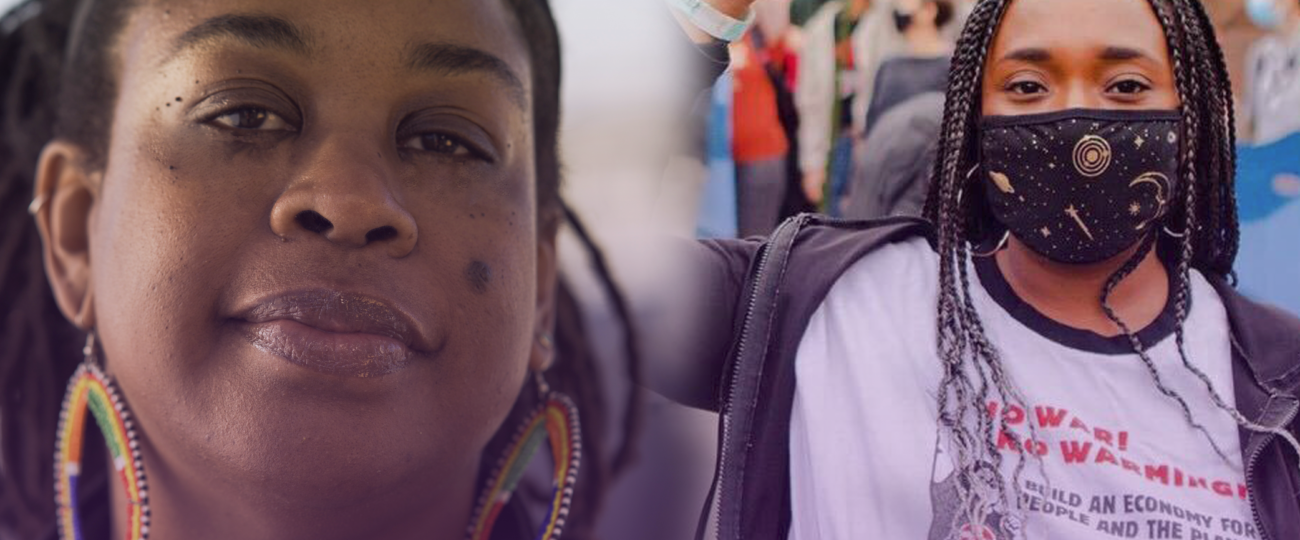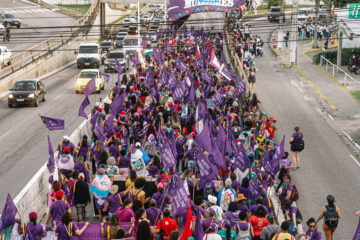“We talk about a triple threat in the United States: poison, pollute and imprison. That is actually the relationship that our government, a settler colonial government, has to the Indigenous and Black folks of this country”. That is how Roxanne Lawson, Co-Deputy Director of Grassroots Global Justice Alliance (GGJ), explains the work of the organization in trying to articulate the environmental justice struggle with the struggles against incarceration, and the current abolitionist movement. In this interview, we have talked to her and with GGJ organizer Siwatu-Salama Ra about the connections between these struggles, and the impacts of incarceration on North American women.
Siwatu-Salama Ra is a Demilitarization Organizer in the environmental justice struggle against gentrification and the aggressive removal of Black and brown communities from Detroit, Michigan. Her struggles were inspired by her mother, who is from the labor and the environmental justice movements in the city. “The way that I came into the movement was through a Black liberation lens that has looked and worked to understand or the impacts of incarceration”. Siwatu explained that incarceration was experienced by her and her family from a very early age, with her father, brother, sister, and later herself, serving some time in prison. “Imprisonment is very much part of our story, but also part of a political analysis of understanding how and what we’re up against as a people”.
What does the abolitionist movement mean nowadays, and how is it connected to the environmental justice struggle?
Roxanne: The abolitionist movement started with the abolition of slavery, and now is about the abolition of policing and prisons. During slavery, slave catchers were the first organized policing and control we had in this society. Police all over the world still function with that same mandate today; control the movement of people to protect the property of the rich. The work of our organization, and of abolitionist organizations and anti-incarceration movements, is to help people understand that all prisoners in our country are political prisoners. Most Black and Indigenous people I know have at least one family member who’s in prison, and that’s not an accident. We often forget that this is how our system is designed.
Similar to the loss that happened where enslaved peoples were kicked out of their native lands, here in the Americas, incarceration means that our families have to renegotiate community and place. When you incarcerate a parent, you incarcerate their entire family. The political, economic, social, environmental, and emotional impacts of that incarceration are felt by the whole family and community.
I believe that environmentalists need to study and adopt more of an abolitionist vision, in part because the people who catch the most hell from our system, outside of Black and brown people, and Indigenous people, are environmental activists. They’re actually struggling for control of what the U.S. government cares the most about, which is land and resources. They are incarcerated because of the desire to protect their communities, so the fight for abolition and decarceration is an environmental fight.
Siwatu: Angela Davis once told me that the anti-prison movement has always seen the environmental justice movement as ground zero, because if there is no environment, then none of this work matters. I hold that very much, because as people who tend to the land and to their communities, we have an analysis of the impacts of incarceration. When incarcerated people describe what was happening climate-wise at the time of their crimes, some of them recall moments of flooding, of being in places with the air was thick with smoke, or water being cut off at their homes. These are very clear stories about how the climate or the environment impacts what I would call crimes of survival, where people are having to choose to radically care for themselves.
The environment impacts people inside the system as well, as many prisons are built on contaminated land — it is extremely detrimental to the people. I remember when I was in prison, the water would come out yellow, and this water was meant for the prisoners and not for the guards.
In the United States, how does incarceration affect women? What is the feminist analysis of the system and the struggles against it?
Siwatu: For the last 50 years, there has been an intentional increase of women, femme, and transgender folks in the prison population. Women are always struggling for survival, and the women whom I met in prison were there for crimes of survival. A lot of women are also in prisons because they are on the frontlines taking care of their families, defending their communities from danger, and protecting themselves.
Also, we’ve seen so many resources taken out of communities. I credit this to the Michigan Governor, Rick Snyder, who was responsible for poisoning Flint’s water system. Besides that, he got rid of the monthly cash assistance that many Black women depended on, leading them to a life below the poverty line. When he took away that cash assistance, we saw the incarceration of women increase in Michigan. And with the increase of women being incarcerated, that also means that people are pregnant and giving birth inside of prisons. People are giving birth in shackles. Women are losing their children to the system and will never see them again.
Roxanne: Women, femmes, and feminists of all genders are at the forefront of abolition and decarceration movements, because we know that it’s fundamentally an illness of our society. It affects us economically and socially. The U.S. didn’t get to be a country that incarcerates more people per capita than any other place in the world without it having an impact on our actual families in our actual communities. We hear those numbers, but what it means is that I have family members in prison, and that means that their children and their nieces and nephews suffer from the breaking apart of families and the loss of family members who are imprisoned.
People are often incarcerated because of crimes of poverty, but regardless, if you are a person of color — you could be Sandra Bland — at any moment, a young woman going to a new job in a new state gets pulled over, is incarcerated for reasons we do not know, and then murdered. Those are the stakes that we live with, and the amount of psychological stress that creates is real because the system is designed to put us in prison and keep us there.
Which are the current struggles of the anti-prison and abolitionist movements organized with GGJ?
Siwatu: GGJ will be launching a multi-sectoral and multi-issue campaign around divesting and investing. This strategy is a framework that comes out of the decarceration movement, an analysis of communities looking at budgets and resources, at the ways communities have been disinvested from, and what sort of resources haven been taken from those communities. GGJ is using this framework as a way to connect our movements more deeply at the intersection of climate, militarism, gender justice, workers’ rights, migrant rights, and thinking about how the best of these practices come together in one campaign. This is best articulated through GGJ’s theory around adopting an anti-racist, feminist, regenerative economy as the alternative.
Roxanne: One campaign that Siwatu is working on, which isn’t run by GGJ, but is one that we and many others are supporting, is Stop Cop City. This is about feminists who understand the dangers of policing on our communities coming together with a clear articulation of how funding a Cop City training city in Atlanta, GA — a majority Black city, will lead to monies invested in increased policing and divested from schools and other public and cultural projects. We’re learning from how they are building across movements.
We also have other member organizations across the country — for example, CURYJ in the Bay Area, who works with formerly incarcerated and system-involved young people. They are helping us figure out what things need to be at the center of a campaign that brings all of us in as equal actors.
We’re working with environmental and economic justice organizations across the country that see their communities being criminalized. Whether they are Indigenous, Asian, Latinx, Black, or Arabic, they see that similar things are happening. Our communities are being pushed out, or having our land taken away from us. Many immigrant communities migrated to escape those reasons, and now we’re having to migrate internally in the United States. Part of what we’re doing is talking to members to figure out what a feminist economy would look like in their communities. We’re taking what we know about feminism, about how it’s decentralized and centered on people’s needs, and bringing that to a national campaign.




